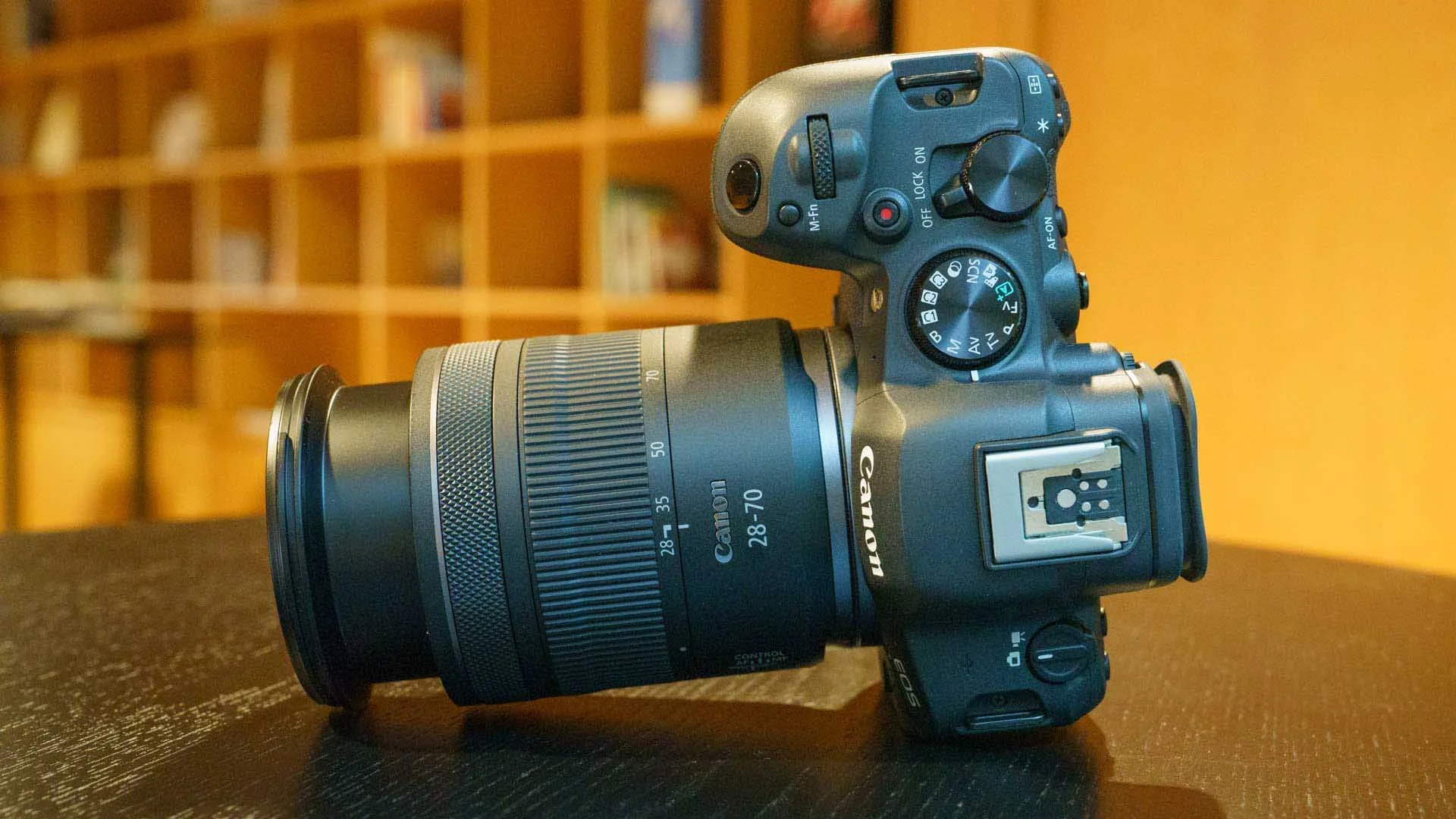
The Canon RF 28-70mm F2.8 IS STM is a versatile, weather-sealed lens that offers enthusiast photographers a significant upgrade from kit lenses such as the RF 24-50mm F4.5-6.3 IS STM and RF 24-105mm F4-7.1 IS STM. Its constant f/2.8 aperture delivers better low-light performance, while its compact size makes it nicely portable for a lens of this calibre. Its autofocus system is fast and quiet and sharpness appears very good in the centre of the frame, but more testing is needed to assess the overall image quality.
Despite being slightly heavier than the RF 24-105mm F4-7.1 IS STM, the wider aperture is an advantage in low light. The collapsible design adds portability but requires an extra step before shooting, which may be a minor inconvenience. Overall, the Canon RF 28-70mm F2.8 IS STM strikes a good balance between performance and size for general-purpose photography.
Constant f/2.8 aperture
Weather-sealed
Compact and lightweight for the aperture and focal length
28mm wide point rather than 24mm
95g heavier than the RF 24-105mm F4-7.1 IS STM
Collapsible design is a pro and con

The Canon RF 28-70mm F2.8 IS STM is a full-frame step-up alternative to kit lenses such as the RF 24-50mm F4.5-6.3 IS STM and RF 24-105mm F4-7.1 IS STM that are often bought with a camera. Aside from its optical design, its key benefit is the constant F/2.8 aperture, which means the exposure doesn’t change when zooming from one focal length to another. Unusually for a non-L-series lens, the RF 28-70mm F2.8 IS STM is sealed against dust and moisture.
With a focal length of 28-70mm, the RF 28-70mm F2.8 IS STM is a good choice for general photography and is suitable for shooting landscapes, still life, portrait, street and travel photography.
The Canon RF 28-70mm F2.8 IS STM’s price is £1,249.99 / €1419.99, and it’s set to go on sale on 27th September 2024.
Lens type: Wide-angle to moderate telephoto zoom or ‘standard’ zoom
Announced: 12th September 2024
Format: Full-frame Mount: Canon RF
Construction: 15 elements in 12 groups with 2 UD and 2 GMo aspherical elements
Coatings: Super Spectra
Number of diaphragm blades: 9
Maximum aperture: f/2.8
Minimum aperture: f/22
Closest focusing distance: 28mm: 27cm (24mm with manual focusing), 70mm: 24cm
Stabilisation: Optical: 5.5EV, Optical & IBIS (In body stabilisation): 7.5EV
Filter size: 67mm
Dimensions (length X diameter): 92.2 x 76.5mm
Weight: 490g
Lens hood: EW-73D (not supplied)
Teleconverter compatible: No

The Canon RF 28-70mm F2.8 IS STM is a full-frame lens and its relatively compact size makes it a good match for the Canon R8, but its constant F/2.8 aperture means it’s also likely to appeal to Canon R6 Mark II users, and perhaps even some Canon R5 II users.
Read our Canon EOS R5 Mark II Review
However, the RF 28-70mm F2.8 IS STM is also compatible with Canon APS-C format RF-mount mirrorless cameras such as the Canon EOS R7 and R10, on which is has an effective focal length range of 44.8-112mm.
Optically, the lens is constructed from 15 elements arranged in 12 groups, with two ultra-low dispersion (UD) elements and two glass-moulded (GMo) aspherical elements. While the UD elements control chromatic aberration and enhance image quality across the frame, the GMo elements help correct distortion and spherical aberrations while keeping the lens size down.
Canon has also applied its Super Spectra Coating (SSC) to improve colour reproduction and reduce flare and ghosting.
It’s worth mentioning again that the lens is weather-sealed, which means it should survive use in less-than-perfect weather.
Having ‘STM’ in its name signifies that the RF 28-70mm F2.8 IS STM uses a stepper motor for autofocusing. This helps keep the lens size down and ensures smooth, quiet focusing. This system also enables a closest focusing distance of 24cm at the 70mm end of the lens and 27cm at the 28mm end. That wide-angle focusing distance can be reduced to match the 70mm end by switching to manual focus mode.
A switch on the side of the lens barrel allows the focus mode to be changed between autofocus and manual focusing. This switch also has a ‘Control’ setting that sets the ring nearest the front element to adjust a customisable feature such as exposure compensation.
If the switch is set to ‘AF’ and ‘Electronic full-time MF is set to ON in the camera’s AF menu, the control ring can be used for manual focusing even though the autofocus system is activated. That can be useful with close subjects or when you need to tweak the focusing.
If Electronic full-time MF is set to OFF in the camera’s AF menu, the ring won’t do anything when the switch is set to AF.
The Canon RF 28-70mm F2.8 IS STM has built-in stabilisation and a claimed shutter speed compensation factor of 5.5EV. When the lens is mounted on a camera with in-body image stabilisation (IBIS), the shutter speed compensation increases to 7.5EV.

Canon has given the RF 28-70mm F2.8 IS STM a collapsible design. This means that before you use it, the zoom ring has to be rotated to the 28mm point to extend the lens to its operational length. When it’s collapsed, the lens measures just 92.9mm in length.
Collapsible lenses are a mixed blessing. It’s nice to have that shorter length for transportation, but it’s a pain to remember to extend the lens before you use it. In fairness, the camera reminds you that the lens needs to be extended if you power it up before the lens is ready for action.
I used the RF 28-70mm F2.8 IS STM on the full-frame 24.2MP Canon R6 II and R8, and it makes a great pairing with both. It looks especially at home on the R6 II.
Read our Guide to Understanding Camera Sensor Size
In appearance and size, the RF 28-70mm F2.8 IS STM is very similar to the RF 24-105mm F4-7.1 IS STM, which at its shortest length measures 88.8 x 76.6mm (L x D) and weighs 395 g. The extra 3.4mm in length is hardly noticeable with the new 28-70mm lens. Of course, there’s a significant change to the focal length range, and the 24-105mm is more versatile in some ways, but the wider aperture of the 28-70mm lens is a significant bonus, especially in low light.
As you might expect, the new 28-70mm lens is substantially bigger than the compact RF 24-50mm F4.5-6.3 IS STM which measures just 69.86 x 58mm and weighs 210 g. However, Canon asserts that the RF 28-70mm F2.8 IS STM produces significantly better image quality than the RF 24-50mm F4.5-6.3 IS STM and RF 24-105mm F4-7.1 IS STM.

Despite its wider aperture, the RF 28-70mm F2.8 IS STM is smaller and lighter than the RF 24-105mm F4 L IS USM (107.3 x 83.5mm and 700g), although again it comes at the expense of the focal length range. According to Canon, the L-series RF 24-105mm F4 L IS USM also produces better image quality than the new RF 28-70mm F2.8 IS STM.
While the Canon RF 28-70mm F2.8 IS STM isn’t an L-series lens, it feels well-made and more robust than an entry-level or regular kit lens. Its two rings rotate smoothly with pleasing friction. The knurled control ring is towards the front of the lens and within easy reach, while the broader zoom ring is around the middle of the barrel, which is the natural point for me to support the lens with my left hand.
Alongside the AF /Control/ MF switch, there’s a switch to turn the image stabilisation on and off. These switches fall within convenient reach of my left thumb when I support the lens.

I have used the Canon RF 24-105mm F4-7.1 IS STM on the full-frame 24.2MP Canon R6 Mark II and R8, and my first impressions are very good. It focuses quickly, quietly and decisively, even in quite gloomy conditions. It also coped well with close, moving subjects.
While there’s a good level of detail and sharpness at the centre of the frame, I need to spend longer with the lens to investigate the peripheral sharpness. However, I have no reason to be concerned at this point.
One of the benefits of a wide aperture is that you can separate your subject from its surroundings by blurring the foreground and background. The RF 24-105mm F4-7.1 IS STM appears to handle out-of-focus areas well with no obvious bokeh aberrations, but I will investigate this further.
In addition, vignetting and chromatic aberration seem to be controlled well, but I need to shoot a much wider range of scenes to be certain. It was raining and overcast when I used the lens, I’ll keep my fingers crossed for some sunshine when I get a sample for full testing so I can check for excessive flare. This will help decide whether the optional lens hood is essential or not.

These images were shot on the Canon EOS R8 and R6 II (which both have a 24.2MP full-frame sensor) with the Canon RF 28-70mm F2.8 IS STM.








Initial impressions indicate that the Canon RF 28-70mm F2.8 IS STM is a solid option for photographers upgrading from a kit lens. While the 28-70mm range may not be as versatile as a 24-70mm or 24-105mm, the lens is compact, weather-sealed, and well-suited to a variety of photography genres, including landscapes, portraits and travel. Its constant f/2.8 aperture also brings low-light flexibility and consistent exposure across its zoom range.
The RF 28-70mm F2.8 IS STM seems to handle well, with smooth zoom and control rings, though the collapsible design means you need to extend it before shooting. The built-in image stabilisation should also prove useful.
I found the autofocus system quick and quiet, and first impressions suggest strong centre sharpness plus good control over chromatic aberration and vignetting. While heavier than the RF 24-105mm F4-7.1 IS STM, the RF 28-70mm F2.8 IS STM offers a wider constant aperture, making it ideal for low-light situations.
In short, the RF 28-70mm F2.8 IS STM appears to combine portability with solid performance, making it an attractive option for enthusiasts ready to move beyond a kit lens.